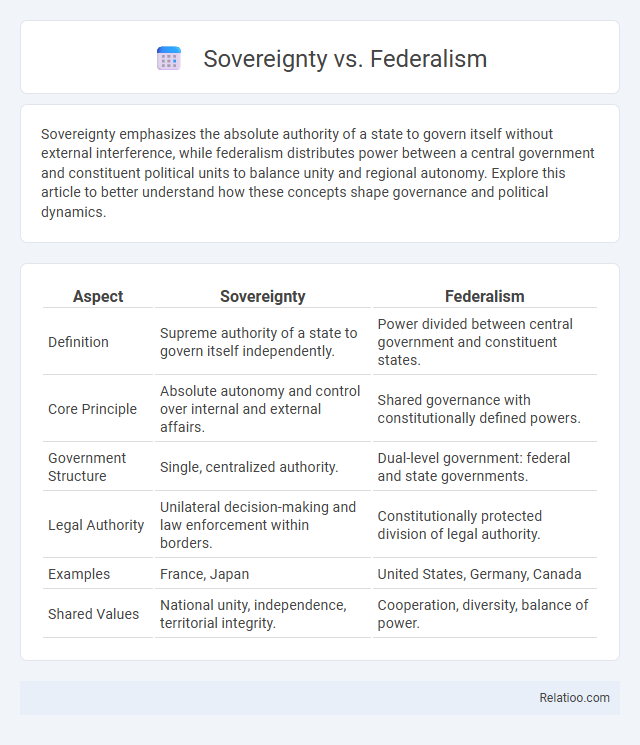Sovereignty emphasizes the absolute authority of a state to govern itself without external interference, while federalism distributes power between a central government and constituent political units to balance unity and regional autonomy. Explore this article to better understand how these concepts shape governance and political dynamics.
Table of Comparison
| Aspect | Sovereignty | Federalism |
|---|---|---|
| Definition | Supreme authority of a state to govern itself independently. | Power divided between central government and constituent states. |
| Core Principle | Absolute autonomy and control over internal and external affairs. | Shared governance with constitutionally defined powers. |
| Government Structure | Single, centralized authority. | Dual-level government: federal and state governments. |
| Legal Authority | Unilateral decision-making and law enforcement within borders. | Constitutionally protected division of legal authority. |
| Examples | France, Japan | United States, Germany, Canada |
| Shared Values | National unity, independence, territorial integrity. | Cooperation, diversity, balance of power. |
Understanding Sovereignty: Core Concepts
Sovereignty refers to the ultimate authority of a state to govern itself without external interference, representing the legal and political independence of a nation. Federalism divides power between a central government and constituent political units, allowing shared sovereignty that balances local autonomy with national unity. Understanding sovereignty helps you grasp how power is distributed or concentrated in different governance systems, impacting legal authority and political control.
Defining Federalism: Structure and Principles
Federalism is a system of government that divides power between a central authority and constituent political units, such as states or provinces, allowing both levels to exercise certain exclusive powers. This structure balances autonomy and unity by enabling regional governments to govern local affairs while the federal government handles national issues like defense and currency. Core principles include shared sovereignty, constitutional division of powers, and mechanisms for resolving intergovernmental conflicts, ensuring a dynamic yet stable political framework.
Historical Origins of Sovereignty and Federalism
Historical origins of sovereignty trace back to the Peace of Westphalia in 1648, establishing the principle of state sovereignty with exclusive authority within territorial boundaries. Federalism emerged as a distinct political system during the late 18th century, notably with the formation of the United States Constitution in 1787, balancing power between a central government and constituent states. The evolution of sovereignty contrasts with federalism's division of authority, reflecting different approaches to governance and political organization.
Key Differences Between Sovereignty and Federalism
Sovereignty refers to the supreme authority of a state to govern itself without external interference, while federalism is a political system where power is divided between a central government and constituent units like states or provinces. Key differences lie in the scope of control; sovereignty emphasizes absolute power within a territory, whereas federalism balances power sharing across different levels of government. Understanding these differences helps you grasp how authority and governance operate in diverse political structures.
Case Studies: Sovereignty in Unitary States
Sovereignty in unitary states is exemplified by centralized authority where the national government holds supreme power, as seen in France and Japan. Unlike federalism, where power is constitutionally divided between national and regional governments, unitary states enforce uniform policies without regional autonomy, ensuring cohesive legal and administrative control. Understanding how Your state's structure compares reveals the impact of sovereignty allocation on governance and legal uniformity across regions.
Federalism in Practice: Global Examples
Federalism divides power between central and regional governments, allowing diverse regions to maintain autonomy while ensuring national unity. Countries like the United States, Germany, and India showcase federal systems where states or provinces have legislative authority over local matters, balancing sovereignty with shared governance. Your understanding of federalism in practice highlights how this structure accommodates regional diversity within a sovereign framework.
Power Distribution: Central Authority vs. Regional Autonomy
Power distribution in sovereignty emphasizes absolute authority held by a central entity, often limiting regional autonomy to maintain uniform control over a nation. Federalism balances power by dividing governance between a central authority and regional governments, allowing states or provinces to exercise self-rule in certain areas while remaining unified under a national framework. Sovereignty, when examined in a federal context, involves a dynamic interaction where both central and regional entities hold legitimacy, ensuring local interests are protected without undermining national cohesion.
Constitutional Implications: Legal Perspectives
The constitutional implications of sovereignty, federalism, and state sovereignty revolve around the distribution of power between national and subnational governments, ensuring a balance that protects Your rights while maintaining national unity. Federalism allocates authority by defining powers reserved for federal and state levels under the constitution, emphasizing legal frameworks like the Supremacy Clause, which mandates federal law's precedence. Sovereignty debates center on the legal interpretation of constitutional limits, impacting jurisdiction, state autonomy, and federal intervention in governance.
Sovereignty and Federalism in Modern Governance
Sovereignty in modern governance refers to the supreme authority of a state to govern itself without external interference, emphasizing territorial integrity and political independence. Federalism, by contrast, divides sovereignty between a central government and constituent political units, allowing for shared authority while maintaining the autonomy of regional governments. This balance enhances governance by accommodating local diversity within a unified state framework, promoting both national unity and regional self-rule.
Challenges and Benefits: Finding the Balance
Balancing sovereignty and federalism involves navigating challenges such as ensuring state autonomy while maintaining national unity, which can lead to jurisdictional conflicts and policy inconsistencies. Federalism offers benefits like localized decision-making and diverse policy experimentation, but sovereignty emphasizes supreme authority that can clash with shared powers. The key challenge lies in designing frameworks that respect state rights without undermining the effectiveness of a centralized government, fostering cooperation and preventing fragmentation.

Infographic: Sovereignty vs Federalism
 relatioo.com
relatioo.com